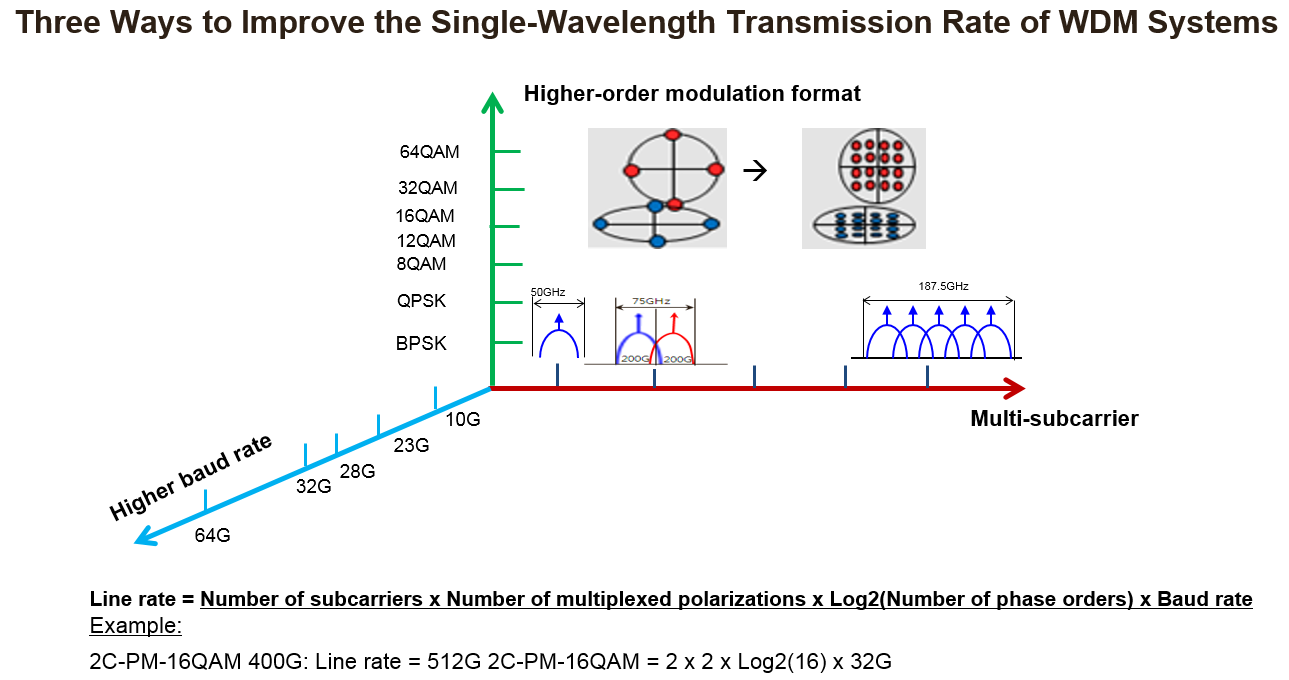Prodotti, soluzioni e servizi per le aziende
With the rapid development of big data, cloud computing, and mobile Internet, more and more enterprises are opting to build multiple data centers, with the traffic between them steadily increasing. Reports indicate that the compound annual growth rate (CAGR) of DCI traffic has reached 31.9%. As a result, current interconnection bandwidth between data centers is insufficient, posing challenges to service development. Effectively increasing DCI bandwidth to meet the requirements of rapid service development and reducing per-bit costs have become the main issues to be resolved by the DCI solution.
In recent years, data center services are developing towards cloud storage, virtual reality, edge computing, machine learning, deep learning, and artificial intelligence. Upper-layer applications demand increasingly higher requirements for network reliability and bandwidth. To address these challenges, data center networks (DCNs) can now provide a single-port 400G capability, core switches can deliver services with 400GE throughput, low latency, and zero packet loss for upper-layer applications, and 400G DC egress routers are gradually being put into commercial use. The DCI network connecting data centers must also adapt to the development trend of DCN and router interfaces, and provide ultra-broadband and high-speed solutions for inter-cloud interconnection to accelerate DCI.
DCI networks have evolved from Internet interconnection and Mbit/s private line interconnection, to 10T-level WDM interconnection, and from single-port optical fiber direct connection to the WDM1era that aims to conserve optical fiber resources, improve fiber utilization, simplify resource management, and achieve fast capacity expansion.
WDM technology inherently exhibits the characteristics of high bandwidth and low latency. The hard pipes provided by WDM ensure data transmission quality, placing WDM as the preferred solution in the DCI high-bandwidth era. Ultra-large data center DCI networks were originally intended for 8 to 10 years of use, however, they now need to be expanded after less than 3 years of service. Faced with such a situation, WDM technology is required to continuously mine fiber transmission capabilities from the aspects of single-wavelength rate and wavelength quantity, and to break through the transmission capacity and distance bottlenecks. In addition, bandwidth upgrades need to be innovated using this technology to reduce the per-bit cost to meet the requirements for effective data center acceleration.
The total transmission capacity of a WDM system can be expressed using the following formula:

In the formula, C represents the total transmission capacity (Tbit/s), R represents the line rate (Gbit/s) of each channel, W represents the spectral width (GHz) occupied by each channel, and B represents the effective spectral width (THz) of the system. There are two methods of increasing the total capacity of a WDM system:
1.Improve the single-wavelength spectral efficiency R/W. Specifically, increase the single-wavelength rate R and reduce the channel bandwidth W.
2.Extend the effective spectral width B.

In terms of single-wavelength rate, DCI networks need to provide 400GE interface transmission capabilities and multi-access-port aggregated transmission capabilities. This means that the single-wavelength capability needs to develop towards a rate higher than 400G. As shown in the following figure, multi-carrier does not increase the single-wavelength rate. When the baud rate remains unchanged, using polarization division multiplexing (PDM)2 and higher-order modulation formats will not increase the channel bandwidth W. In optical communications, light is generally split into optical signals in two vertical polarization directions, x and y, to carry more information and improve the transmission capacity. (Theoretically, light can be split into multiple polarization directions to carry more information, but modulation and demodulation are difficult. Therefore, this mode will not be put into commercial use in the near future.) When the modulation format remains unchanged, using a higher baud rate will increase the channel bandwidth W, which may not contribute to improving the total capacity of WDM systems. To summarize, the key to improving the single-wavelength rate is to improve both the modulation format and baud rate. In addition, due to the Shannon limit, when the single-wavelength rate increases continuously, the ultra-high speed transmission distance of a single wavelength is limited by the available signal-to-noise ratio (SNR). Approaching the Shannon limit and improving the system transmission distance availability by using coding/decoding technology and shaping compensation algorithm, while at the same time increasing the single-wavelength transmission capacity, is a problem that needs to be solved immediately.

In terms of wavelengths, the commonly used C band 80-channel/96-channel systems cannot meet the requirements of ultra-large data centers. Similar to wireless technologies, the spectral width has to be extended and wavelengths need to be expanded to new bands (such as ultra-wide C band and L band). This is the direction that industry research and product development are currently taking. In addition, once optical-layer platforms are deployed, the maximum number of wavelengths is fixed, and they cannot withstand frequent service interruptions caused by optical-layer reconstruction in the future. As a result, the optical-layer smooth expansion capability needs to be reserved in the initial deployment. To support wider bands, multiplexer/demultiplexer boards, electrical-layer OTU boards, and other optical-layer boards, including lasers, amplifiers, and receivers, require technological innovation.
In conclusion, the key to effective DCI acceleration lies in whether the WDM-based DCI technology can effectively improve the single-wavelength rate and increase the number of wavelengths, driving technical breakthroughs in hardware design, algorithms, and system components such as chips, lasers, receivers, and amplifiers to continuously approach the Shannon limit. Currently, single-wavelength 100G/200G is the mainstream commercial DCI technology, single-wavelength 400G/600G has been successfully put into commercial use, and single-wavelength 800G is expected to be put into commercial use sometime in 2020. Let's stay tuned for its single-fiber capacity, transmission performance, and involved key technologies.
1 WDM: Wavelength Division Multiplexing. This technology concurrently transmits optical signals of two or more wavelengths through an optical fiber.
2 Polarization division multiplexing (PDM): The method used for carrying different information using waves of two orthogonal polarization states in an optical fiber.